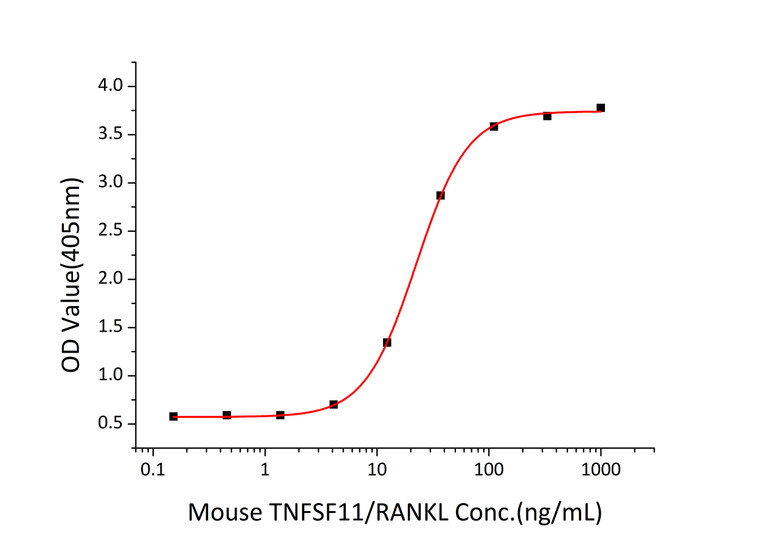| Host: |
HEK293 cells |
| Reactivity: |
Mouse |
| Note: |
STRICTLY FOR FURTHER SCIENTIFIC RESEARCH USE ONLY (RUO). MUST NOT TO BE USED IN DIAGNOSTIC OR THERAPEUTIC APPLICATIONS. |
| Short Description: |
Recombinant-Mouse TNFSF11/RANKL/CD254-N-6His protein was developed from hek293 cells and has a target region of N-6His. For use in research applications. |
| Formulation: |
Lyophilized from a 0.22 Mu m filtered solution of PBS, pH 7.4. |
| Storage Instruction: |
Store at-20°C for up to 1 year from the date of receipt, and avoid repeat freeze-thaw cycles. |
| Immunoreactivity: |
Measured by its ability to induce osteoclast differentiation of RAW 264.7 mouse monocyte/macrophage cells. The ED50 for this effect is 11.19-44.76 ng/mL, corresponding to a specific activity of 2.23×104~8.94×105 units/mg. |
| Gene Symbol: |
Tnfsf11 |
| Gene ID: |
21943 |
| Uniprot ID: |
TNF11_MOUSE |
| Immunogen Region: |
Arg72-Asp316 |
| Immunogen: |
Recombinant Mouse TNFSF11/RANKL/CD254 Protein is produced by HEK293 cells expression system. The target protein is expressed with sequence (Arg72-Asp316) of mouse TNFSF11 (Accession #NP_035743.2) fused with a 6×His tag at the N-terminus. |
| Post Translational Modifications | N-glycosylated. The soluble form of isoform 1 derives from the membrane form by proteolytic processing. The cleavage may be catalyzed by ADAM17. A further shorter soluble form was observed. |
| Function | Cytokine that binds to TNFRSF11B/OPG and to TNFRSF11A/RANK. Osteoclast differentiation and activation factor. Augments the ability of dendritic cells to stimulate naive T-cell proliferation. May be an important regulator of interactions between T-cells and dendritic cells and may play a role in the regulation of the T-cell-dependent immune response. May also play an important role in enhanced bone-resorption in humoral hypercalcemia of malignancy. Induces osteoclastogenesis by activating multiple signaling pathways in osteoclast precursor cells, chief among which is induction of long lasting oscillations in the intracellular concentration of Ca (2+) resulting in the activation of NFATC1, which translocates to the nucleus and induces osteoclast-specific gene transcription to allow differentiation of osteoclasts. During osteoclast differentiation, in a TMEM64 and ATP2A2-dependent manner induces activation of CREB1 and mitochondrial ROS generation necessary for proper osteoclast generation. |
| Protein Name | Tumor Necrosis Factor Ligand Superfamily Member 11Osteoclast Differentiation FactorOdfOsteoprotegerin LigandOpglReceptor Activator Of Nuclear Factor Kappa-B LigandRanklTnf-Related Activation-Induced CytokineTranceCd Antigen Cd254 Cleaved Into - Tumor Necrosis Factor Ligand Superfamily Member 11 - Membrane Form - Tumor Necrosis Factor Ligand Superfamily Member 11 - Soluble Form |
| Database Links | Reactome: R-MMU-5668541Reactome: -MMU-5669034Reactome: -MMU-5676594 |
| Cellular Localisation | Isoform 1: Cell MembraneSingle-Pass Type Ii Membrane ProteinIsoform 2: Cell MembraneIsoform 3: CytoplasmTumor Necrosis Factor Ligand Superfamily Member 11Soluble Form: Secreted |
| Alternative Protein Names | Tumor Necrosis Factor Ligand Superfamily Member 11 proteinOsteoclast Differentiation Factor proteinOdf proteinOsteoprotegerin Ligand proteinOpgl proteinReceptor Activator Of Nuclear Factor Kappa-B Ligand proteinRankl proteinTnf-Related Activation-Induced Cytokine proteinTrance proteinCd Antigen Cd254 Cleaved Into - Tumor Necrosis Factor Ligand Superfamily Member 11 - Membrane Form - Tumor Necrosis Factor Ligand Superfamily Member 11 - Soluble Form proteinTnfsf11 proteinOpgl proteinRankl proteinTrance protein |
Information sourced from Uniprot.org
12 months for antibodies. 6 months for ELISA Kits. Please see website T&Cs for further guidance








